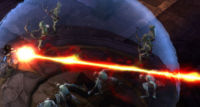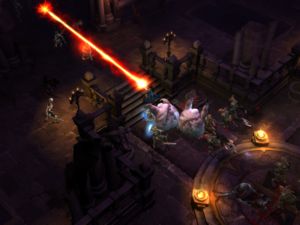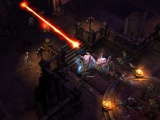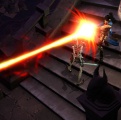Disintegrate (BlizzCon 2008)
Disintegrate is a Tier 2 skill from the Wizard's Arcane skill tree, doing damage to opponents in an AoE line.

|
Archived Article [e] Disintegrate (BlizzCon 2008) is an archived article about material previously included in Diablo 3. However, it has currently been removed or the article contains outdated facts. The information is stored in Diablo Wiki for posterity. Please note: Links in this article lead to both updated and archived material. This article was last up to date:Currently updated version of this article is: |
Contents
Background[edit | edit source]
| Diablo III Skill [e] | |
|---|---|

| |
| Disintegrate Active, 1 ranks | |
| Used by: | Wizard |
| Emanate a beam of pure energy dealing X arcane damage per second. Damage is modified to 80% each time the beam passes through the target. | |
| Type: | Direct Damage |
| Quantity: | 10 damage/sec |
| Effect: | Line AoE |
| School: | Arcane |
| Mana cost: | 12/sec |
| Cast time: | Instant |
| Duration: | Concentrate? |
| Cooldown: | Unknown |
| Synergies: | None |
| Requires: | N/A |
| Prereq of: | N/A |
A Wizard can call forth a torrent of Arcane energies to make matter simply vanish.
Skill Design[edit | edit source]
Disintegrate fires a red, ruler-straight laser beam of arcane damage, striking everything in a line AoE right to the edge of the screen. The beam remains active as long as the mouse button is depressed (mana permitting), and can be moved around in all directions, emanating out from the stationary Wizard like spikes from a hub.
Disintegrate isn't that damaging and has a fairly high mana cost. The power of it comes from the speed; it moves at the speed of light, and unlike the other projectiles in Diablo III, instantly hits anything it's aimed at. This spell is at its best raking through a line of ranged attackers, especially when aimed at enemies on the very edge of the screen. The Disintegrate laser will hit them instantly, while their arrows (or other attacks) must travel across the screen before they become damaging. It's quite possible to cook targets for a second, kill them, and then move before their projectiles reach you.
This might be the best use of this skill late game; even if the damage doesn't scale up to keep it a killer, it could hit anything on the screen, instantly "silencing" enemy mages and summoners. (Depending on how difficult it is to trigger crits with Arcane damage.
This spell drains mana and deals damage steadily, at 12 points per second. The disintegrate laser will hit an unlimited number of monsters at once, dealing 80% of the damage on the target behind the previous one. Basically, it would deal 100% to the first one, 80% to the second, then 64%, 51%, 41%, 33%, etc, so it's still at least partially useful even after five or six enemies.
In the demo build at BlizzCon 2008, this spell wasn't very useful against large enemies, but was devastating against smaller enemies, especially ranged attackers such as Skeletal Archers. The Disintegrate ray hits anything on the screen more or less instantaneously, so nothing is out of reach and there's no delay between clicking the mouse and hitting the enemy with the spell. This one will surely be nerfed somewhat before the final game, since it was just so useful in the '08 build.
Hands on Report[edit | edit source]
Flux was able to use Disintegrate while at BlizzCon, and discussed it at length in his BlizzCon Wizard gameplay report.
- Disintegrate was the the most fun, or at least most talked about, Wizard skill from Blizzcon. Virtually everyone put a point into Disintegrate, either because they liked the name, or because they’d seen someone else using that red laser of death, and wanted to try it themselves. (I fell into the later camp.) Disintegrate has been featured in a variety of screenshots; the straight red laser line it emits is hard to mistake. When using this skill, the Sorceress emits a laser-like beam of red energy that passes through multiple targets, dealing progressively less damage to each. What makes it so distinctive is that it stays active as long as you depress the mouse button (and have enough mana), and that it can be aimed like a beam weapon and swept from side to side. It's indisputably fun to stand there and basically hose down every enemy in sight, without moving a step.
- What makes the spell so effective is not the damage, which is fairly low. (It deals 10 damage per second.) It's the speed, since unlike every other Wizard skill (and every Sorceress skill) this one moves at the speed of light. The instant you click the mouse, Disintegrate is hitting things at the edge of the screen. The damage is lessened by each monster it passes through, but in practice (at least in the early going) this just means it can kill everything you shoot at in 5 seconds. The ones in front die in 2 seconds, and as soon as they're down the damage increases to the ones behind them.
- Disintegrate is most effective against weaker enemies in bunches, and especially against ranged attackers at the far edge of the screen. I constantly found skeletal archers at the edge of the screen, and used Disintegrate to obliterate them before they could do more than get off a single shot at me. Killing them with say, Magic Missile, would have taken much longer. I would have had to cast half a dozen missiles, they would have had to fly all the way across the screen, monsters in the way would have absorbed some of them, and all that while the archers would have been firing at me. Thus Disintegrate isn't hugely damaging, but it saves you a great deal of time and damage by instantly wiping out low hit point enemies from a distance.

- On the other hand, Disintegrate was not very effective against larger targets. Bosses or big monsters were hurt by it, but not nearly as badly as other spells hurt them. It's said that Disintegrate increases in damage the longer it's trained on the same enemy. I was never able to test that out (it killed all the small stuff and ranged attackers too quickly), and it's not listed in the spell's hover description, but even if it's true, it's hard to use this spell for that purpose when you're playing alone. Big monsters don't stand back and let you fry them; they rush up to attack you, and up close Spectral Blade or Magic Missile did far more damage than Disintegrate. I don't think Disintegrate would be a great choice against a powerful ranged enemy either, such as a boss pack of archers, since while it would be useful to kill them, you have to stand still while you're using it, and their arrows would pin cushion you in the meantime.
- That's one of the most interesting things about using Disintegrate; that it's more effective if you're not moving. But Wizards seldom have that luxury, at least not when they're playing alone. A solo Wizard is a hit and run machine, throwing magical projectiles, rushing back or to the sides to dodge returned fire, darting in to land a few Spectral Blade strikes, etc. Disintegrate looks like it'll be very useful against weak, ranged attackers, or else will be best used in a multiplayer game, when some other character is up front tanking, giving the Wizard the freedom to pour this one on non-stop.
Skill Rank Table[edit | edit source]
- Rank 1: 10 damage/sec. 12 mana/sec.
Only Rank 1 is known so far.
Synergies[edit | edit source]
- None known.
Skill Rune Effects[edit | edit source]
- None known.
Development[edit | edit source]
Disintegrate was first shown at BlizzCon 2008 when the Wizard was unveiled. It was slightly updated in the version shown at BlizzCon 2009. You can find the latest version here
Trivia[edit | edit source]
With Diablo III, Blizzard have looked more at the traditional Dungeons & Dragons pen & paper RPG for inspiration. The The Disintegrate spell is one of the "trademark" D&D spells, which name is likely taken in tribute to the pen & paper RPG.
Media[edit | edit source]
You can find pictures in the Diablo 3 screenshot and picture gallery:
Disintegrate used in a Slow Time bubble.
Disintegrate used on Zombies.
Disintegrate used on a Skeleton.
Related Articles[edit | edit source]
References[edit | edit source]
| Arcane Skills [e] | |||||
|---|---|---|---|---|---|
| Tier I |
Tier II |
Tier III |
Tier IV |
Tier V |
Tier VI • Teleport |




